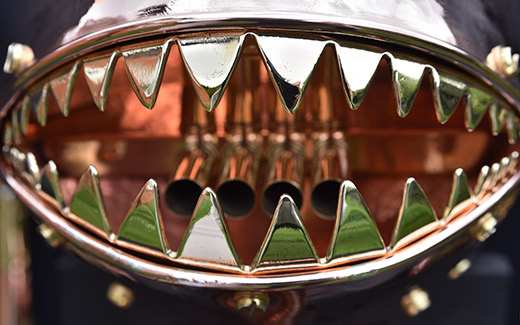Gossifer Aquatic Cleansing Machine
| < previous work | next work > |

(Click on any image to enlarge)
 |
 |
 |
 |
 |
 |
 |
 |
 |
 |
 |
 |
 |
 |
 |
 |
 |
 |
 |
 |
 |
 |
 |
 |
The Victorians were potty about aquariums - both institutional (Brighton, Crystal Palace) and domestic (which they treated like we do television). So, continuing my theme of improving the lot of the Victorian/Edwardian gentleman, I figured that it would be excellent to further reduce the need for the usual expensive servants, and have an appliance adept at keeping your aquarium clean for you. The result: the ‘Gossifer Aquatic Cleansing Machine’! It'll wizz about your aquarium all day, keeping it completely clean without any attention whatsoever, ingesting all the undesirable bits through its many suction funnels and filters (even using that as fuel, along with the plankton it sucks in through the multiple pipes in its mouth). And woe betide any real fish that get in its way!
This piece is named after Philip Henry Gosse (1810-1888), who first coined the now familiar term 'aquarium', in his 1854 book 'The aquarium: An unveiling of the wonders of the deep sea'.
It comes with its own 'aquarium' for display (completely watertight, honest guv). And it's guaranteed never to bite your fingers off - as long as you keep them out of the aquarium!
Materials: brass, copper, wood, grease guns, shell cases, opera-glass
lenses, musical instrument parts, taps etc
Dimensions: 25" long x 14" wide x 17" high (63cm x 35cm x 43cm)
Height on stand: 18" (46cm)
Weight: 20lb (9kg)
Weight of stand: 2lb (1kg)
Dimensions of 'aquarium' display structure: 36" long x 21" wide x 21"
high (92cm x 53cm x 53cm)
Weight of 'aquarium' display structure: 3lb (1.3kg)
DESIGN AND CONSTRUCTION NOTES
- the piece is built up on a backbone of large square-section aluminium
- upon which are mounted a set of seven unique wood profiles
- to which the main body panels and the head are bolted
- the tail, the lower horn, the two downward-facing side horns, the propeller and the waterjets support plate are all bolted directly to the backbone (passing through the body panels)
- construction started with a full-size side-elevation drawing, showing the backbone, outline and profile positions and heights. Profile outlines were developed as multiple overlays on a single drawing
- card templates were developed to determine the size, shape and fitment of each body panel, before cutting copper
- the fin is made from a single piece of 3mm brass plate, with perhaps 15 separate processes applied to achieve the 'soft' polished brass appearance
- the texture of the body panels is achieved by manually hammering against a steel dolly, with approximately 1000 hammer blows applied to each panel (of which there are 14, plus 2 head panels and 6 tail-interface panels)
- the tail is laminated from 3 separately-profiled pieces of brass plate
- the'waterjet propulsion units' at the rear are motorcycle tool-kit grease-guns, which were still full of grease when I started the project!
- the piece is held together with approximately 100 bolts externally, each one of which was individually polished. There is a larger number out-of-sight inside (not polished!)
- it is theoretically possible to completely dismantle the piece into its component parts by undoing all the bolts. However, I would not recommend this procedure!
This piece was shown for the first time in the Gloucestershire Guild of Craftsmen 'Crafts Alive' exhibition at Rodmarton Manor in September 2023.
It has also been featured on the front page of the Newbury Weekly News 'N2' Arts & Entertainment section. Read the article here.
If you would like to buy any sculptures or are interested in including work in an exhibition, please contact us for details of viewing and/or shipping arrangements.
New sculptures are being created all the time, and pieces can be sold or go off to exhibitions at any time, so please check back here regularly for updates.
For details of exhibitions of work by Nigel Williams, please click here.


